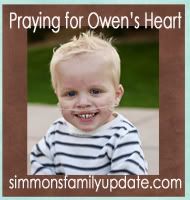What a mouthful, right?
Gavin just got diagnosed with this chronic, long-term, seemingly heart-breaking disorder. I hate to say this, but in a way, it's almost worse than Grace's cardiac defect. At least with Grace, she doesn't experience chronic pain ALL day EVERY day. I know that is silly, but at this point, I am 100% overwhelmed.
Frustrating to think of two very chronically "ill" children. I had dreams of going back to work someday, now that seems doubtfully possible. Our days are filled with appointments, therapies, feeding battles (for both), and sleep, sweet, sweet sleep. I'm a self-described loner these days. Except for a very few close friends, it's hard to find others that understand me and my kids, and what we're going through. I'm having a pity-party day- and I'm in a poopy mood.
This too shall pass.... right?
What is Eosinophilic Esophagitis?
In a healthy person, there are absolutely no eosinophils in the esophagus. There can be a few in the lining of the gut, but there should be none in the esophagus. A few can be found with reflux. A biopsy with an eosinophil count of 15-20 or more per high power field (under the microscope), may be caused by Eosinophilic Esophagitis. Other potential causes are Gastroesophageal Reflux Disease (GERD), food allergies and irritable bowel disease.
Unfortunately, many people go undiagnosed for years, suffering with what can be severe symptoms. Some people aren’t diagnosed until they are teens or adults and seek treatment when food has become impacted in their esophagus.
Recent studies at Cincinnati Children’s Hospital have shown that Eosinophilic Esophagitis is even more common than other well known diseases that affect the gastrointestinal tract such as Crohn's Disease and Cystic Fibrosis. Eosinophilic Esophagitis is the most prevalent of the Eosinophilic Gastrointestinal Disorders.
The current (*) estimated prevalence of Eosinophilic Esophagitis is 1 in 2000.
(*estimate as of 2007)
Symptoms of Eosinophilic Esophagitis include:
![]() Reflux that doesn’t respond to acid reducing medication (i.e. Proton Pump
Reflux that doesn’t respond to acid reducing medication (i.e. Proton Pump
Inhibitors, such as Prevacid, Prilosec and Protonix)
![]() Nausea
Nausea
![]() Vomiting
Vomiting
![]() Dysphagia (difficulty swallowing)
Dysphagia (difficulty swallowing)
![]() Food impactions (food gets stuck in the throat)
Food impactions (food gets stuck in the throat)
![]() Abdominal or chest pain
Abdominal or chest pain
![]() Failure to thrive (poor growth or weight loss)
Failure to thrive (poor growth or weight loss)
![]() Malnutrition
Malnutrition
![]() Poor appetite
Poor appetite
![]() Early satiety (feeling full sooner than you should)
Early satiety (feeling full sooner than you should)
![]() Difficulty sleeping
Difficulty sleeping
In addition to the above, some people also experience pain in their lower limbs (legs, ankles & feet) which is not uncommon with GI disorders in general, ear infections, asthma, croup, migraines, mysterious fevers, and more frequent “colds” when they are reacting to a food. Behavioral changes have been reported in some children (*) and Autism Spectrum Disorders are not uncommon. (*If your child has ongoing behavioral issues, social skills difficulties or any developmental issues, you should speak to your child’s Dr and consider an evaluation by a Developmental Pediatrician.)
A diagnosis is made when an endoscopy is performed (by a Gastroenterologist) and multiple biopsies are taken. Eosinophilic Esophagitis can NOT be diagnosed by symptoms alone. An endoscopy with biopsies is the only way to properly diagnose EoE. Even if the esophagus looks fine to the person performing the scope, the biopsies may still show EoE. It should be noted that even if the esophagus looks normal, the presence of eosinophils (which would be seen in the biopsies) can, and often will, still cause symptoms. However, the Dr. may also see rings or furrowing, thickened folds, microabcesses, white plaques, etc. The pathologist will also look for tissue injury, swelling and thickening of the esophageal layers. With Eosinophilic Esophagitis, the eosinophils are limited to the esophagus and not found in other areas.
The formal diagnostic criteria should be in place soon, but Eosinophilic Esophagitis can be diagnosed when the number of eosinophils in a esophageal biopsy is greater than 15 – 20 per HPF (high power field) under the microscope. Multiple biopsies need to be taken, as it tends to present in patches. It is recommended that 4-5 biopsies be taken from each area of the esophagus: 4-5 from the top (proximal), 4-5 from the middle, and 4-5 from the bottom (distal esophagus), because with any less, it may be missed.
Once Eosinophilic Esophagitis has been diagnosed, food allergy testing is usually recommended to guide treatment. Skin prick testing (SPT) to different foods is the most common type of allergy testing, and may prove helpful, but EoE is caused by a delayed reaction, not an immediate reaction as is tested for via SPT. Patch testing, which looks for delayed reactions, is also being used with some success. However, it is not uncommon to have negative allergy testing and still react to those foods that are being tested. An EoE reaction can range from days to weeks as the number of eosinophils increase and cause damage to the esophagus.
Please note that if you or your child have previously had an endoscopy, but the number of eosinophils was not quantified (counted), you are still able to ask the doctor to have the biopsy slides reviewed and have them counted. Even if the biopsies are several years old, they can be pulled from storage (they are archived) and the can be reviewed / re-read. The report can then be amended to indicate the eosinophil count, even if it is zero.
Treatment:
There is NO cure for Eosinophilic Esophagitis, but the goal of treatment is to eliminate the eosinophils in the esophagus, thereby alleviating symptoms. The treatments include dietary restrictions and medications. Since EoE is usually food-driven (caused by a reaction to certain foods), most kids and adults with EoE respond well to dietary treatments, and this may be all that is needed for many people. However, once treatment is discontinued, the eosinophils along with the damage they do, will return. Treatment needs to be ongoing, which may mean continuing to avoiding the food triggers and/or taking medication.
Elemental diet consists of a medical food (elemental formula), without any proteins, either in its whole or incomplete form (pre-digested or hydrolyzed). Elemental formulas are made of amino acids (the building blocks of proteins), fats, sugars, vitamins and minerals. Amino acids do not cause allergic reactions but whole or partial proteins can.
Although new flavors are available to make the formulas more palatable, kids and adults who need elemental formula may have a difficult time drinking enough of it. To maintain proper nutrition, some require enteral feeding tubes, to allow the formula to go directly into the stomach.
Medications for Eosinophilic Esophagitis most commonly include steroids to control inflammation and suppress the eosinophils. Steroids are used if dietary changes do not resolve the symptoms. They can be taken orally or topically (swallowed from an asthma inhaler). Side effects from steroids often limit long-term use of oral steroids. Without removing the cause of the symptoms via dietary restrictions, the eosinophils will return once the medication is discontinued. The doctor will determine which, if any, medications are appropriate for each individual.














This really stinks. I feel so bad for little Gavin :( I can't imagine how that must feel and for you to watch little man in such pain :( Pity Party Allowed.
ReplyDeleteAnneke.. I'm so sorry. It sounds like you got a diagnosis fairly quickly and now you know what's causing the pain. Cry it out. We're here if you ever want to talk.
ReplyDeleteOH MY, I am so sorry! You deserve a pity party! It is not fair that your sweet little guy has this. Hopefully treatment will help him out now that you know what he has. Praying for relief!
ReplyDeleteMy son has just been diagnosed with EOE. I am so grateful to have stumbled upon your blog. You mentioned that people with EOE sometimes have foot/ankle pain and ear infections etc. Our doctor has not addressed this and our son is in pain every single day! I am so grateful to perhaps at least have the beginnings of an explanation. THANK YOU and God bless
ReplyDeleteI have come across your blog looking for some guidance- we are searching for a GI dr. in the phoenix area. WE believe she has EOE and are looking for a good doctor to take her to. Any suggestions would be truly appreciated. She has been referred to Dr. Montes at PCH but we are hoping to find someone whose child has EOE for a recommendation outside of a generic referral from her pediatrician. Thanks in advance
ReplyDeleteI just stumbled upon your blog. First I have to say thank you for taking the time to write down your thoughts. My son just turned 4 and won't eat. He will say eating hurts him. He was a premie, has asthma and hay fever, and had no problem until about 2 years old. He WILL NOT eat any breads or meats. He basically lives on apples. My "mom instinct" kicked in a while ago when I noticed he would flat out refuse food. Everyone around me thought I was insane. "He is just picky - kids are picky you know, even you were a picky eater". I might have been picky but I at least ate. It is very hard to watch/listen to your child say they are hungry constantly but not be able to/want to eat anything. We have been referred to feeding team upon feeding team. People think I am "LUCKY" because my child will only eat fruits and vegetables. It is not lucky to have a 4 year old that only eats one apple ALL DAY. It is scary and heart breaking. Thank you for allowing me to vent on your blog. I have been searching for support groups. Or just an ear to listen. I hope you have found some even ground (as I notice that this post was a while ago).
ReplyDeleteWhen you find yourself dreading dry or dense foods because you have difficulty swallowing them, take note! You might have eosinophilic esophagitis. This means your esophagus narrows so much that food gets stuck, resulting in impaction – which is a medical emergency. Have yourself checked for it – don’t just assume that you have food allergies or just need to chew your food more thoroughly!
ReplyDeleteclick here for more details